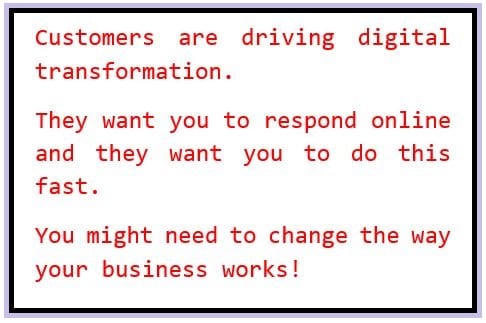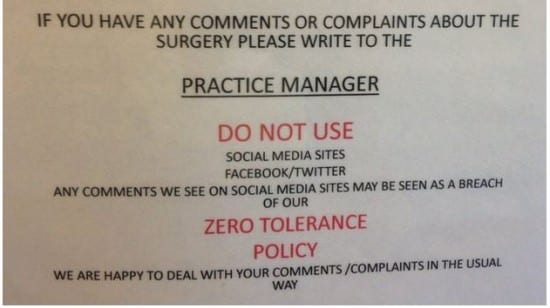3 actions to kickstart Digital Transformation
Take a deep breath, you’ve managed to get the senior team to commit to a digital project and your digital transformation journey has started. The next stage requires a sprint! A big leap forward to catch up with or leapfrog the competitors. Here are three actions you can take now:
- 1. Benchmark against the competitors
- 2. Listen to your customers
- 3. Build a team
1. Benchmark your business against the competitors
Benchmarking will identify the biggest gaps and generate a priority action list. There are many tools available to enable you to benchmark your digital marketing capabilities as part of strategy development.
Strategic Benchmarking Tool
One of my favourites is this strategic benchmarking tool. It doesn’t require a lot of effort, so it’s painless, although the questions are thought-provoking. You could ask several team members to complete and then compare results. Simply select your answer from a drop down box and you’re graded. The questions explore how your business operates in the digital world as well as how your competitors do the same. You can then see a radar map showing the position of your business against the competition. What’s also useful is that for each of the 40 questions there is a link to another resource with more information if you’re not sure about the question.
Tools for reviewing competitors’ content marketing performance
If content is a big issue to your business you may find this article useful; 3 free analysis tools for reviewing competitors’ content marketing performance. Again this will show any potential shortcomings in this area.
Online competitor benchmarking tools
A full suite of competitor benchmarking tools is available, categorised in to the different stages of your digital journey. Useful and many of these tools are free, it’s good to be able to pick and choose as needed.
Competitor benchmarking guide
If you need a more structured approach, this guide will show where you need to improve and it includes many templates for competitor comparison.
Listen to your customers
When you’ve understood the shape of your business, it’s useful to get some customer feedback. There are many tools available to check your website, garner product opinions, as well as a raft of general survey tools.

Talking to your customers is so important. How many times have you said ‘that’s not what I need, they just don’t get it!’ Digital transformation isn’t about using Facebook and Twitter, it’s about harnessing the digital agility of your customers and more closely meeting their needs – meeting customers’ needs used to be called marketing!
To discover customer needs or improvements to your digital services, ask them! This blog post, Website Customer Feedback Tools review, provides lists of the different tools available to explore.
And be prepared! Not all of the news may be what you want, but requesting feedback, especially for the first time, can result in issues customers have had for ages, but don’t feel listened to. Once they get the opportunity to share, they will.
Be prepared!
- Anticipate the most common questions or issues that will arise, worst case scenario.
- Prepare statements to address each of these, but carefully! Don’t argue with customers. Give them information (nicely) and say how you’ll get this sorted out.
- Make it personal. Ensure you add a real name, not a corporation to every sign off.
2. Best practice managing customers online
Get and act on feedback, add the human touch as it’s harder to be rude to a real person.
A great example is @LondonMidland trains, a relatively small train operator in Europe who manage their customer service via Twitter. They start with their rules of engagement – a good way to avoid entire policies on acceptable behaviour.

And in their tweets, to manage handovers between staff, they add personality and demonstrate that they want to engage.

A really poor example is trying to keep the conversations in a closed loop and out of social media. Worse still, threatening customers if they don’t follow these rules!
Two scary examples of managing customers online
A GP’s practice, where, it seems as if they wish to avoid online conversations have threatened their patients with exclusion if they discuss their surgery online. Since this notice was created and shared widely, it has been changed.

And what is 'the usual way'?
A hotel in the USA, Union Street Guesthouse in Hudson, New York, is a historical building. Travellers who expected to stay in a standard 4 star hotel and on arrival, discovered it wasn’t what they expected. This was a particular issue with wedding guests. To manage their reviews, rather than having a ‘one to one’ with their guests, they posted their policies on their website:

This was followed by this statement, which at the time of writing this post had been removed, but I found it via the wayback machine.

It’s an interesting approach, but not one we’d recommend! For more on customer feedback, check our hub page.
3. Build a team
When you have identified the customer needs, build a team to take the big leap forward and share the work. This is a Digital Working Party, the Digital Group or the Digital Collective – different organisation use different terms. This is the start of your digital centre of excellence.
The best teams I’ve worked with include:
- Someone very senior – they don’t attend every meeting, but their support is there when needed.
- Someone senior in marketing who manages when meetings take place.
- Someone senior in IT.
- Someone senior in customer services.
- Some representatives from Sales.
- People from both IT, marketing and other departments. Other departments can be admin, finance – those with a passion for digital as they bring a new dimension to the group.
And make sure your agencies and other partners you are working with understand digital! There are plenty of ‘snake oil’ salespeople out there. Telling customers they can’t access Google Analytics, they cannot change items on their Facebook page… Are they qualified? Do they have experience over a long period of time? Verify skillsets within your partners to ensure that they can contribute to your big leap.
If you’re a smaller business, the group will be smaller too. Ensure the key people are involved as if they participate, research shows they are more likely to support!
Best practice in your Digital Working Party
Within your Digital Working Party you may find there are skills gaps. Early on, get some outside help (especially if this is new to you) and do a skills audit to see what’s needed. Not everyone needs CAM, CIM, Smart Insights or IDM qualifications (although that is the gold standard) but it’s really useful to have a few people in the team with some formal qualifications. They can share tools and templates as well as bringing structure to the group. And don’t forget those that have been in marketing and PR for years. They understand crisis management and in this new digital age a badly worded post can become an overnight crisis.
It’s all about balance. Ensuring you’ve got a mix of positive people who want to take the project forward.
How do you manage the teams? In my next post I will look at maximising digital performance and what this involves.
Does any of this sound familiar? Do you have clients (if you’re agency-side) where you’re trying to influence the digital journey? Are you company-side and a lone voice trying to convince others? Do share – even anonymously, it would help!













